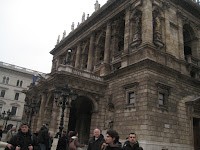1) State Opera House
2) Parliament
3) St. Stephen's Basilica
1) State Opera House
Opera seems to be one of the great forms of entertainment for the residents and tourists in Budapest. We didn't have a chance to see the opera itself (just because we were hesitant to disrespect others with jeans), but we did have a chance to go on a tour of the opera house.
The opera house was built from 1873 to 1884. Even WWII didn't destroy the building. The old looking building has a very sturdy look with a little bit of "eastern" flavor to its roof.
 Inside is not too big but gorgeous with lots of decorative wood curvings, gilding, and chandeliers. The theater is made all out of wood to create better acoustics. I heard that it was ranked as the 3rd best acorstics in Europe after La Scala in Milan and the Palais Garnier in Paris.
Inside is not too big but gorgeous with lots of decorative wood curvings, gilding, and chandeliers. The theater is made all out of wood to create better acoustics. I heard that it was ranked as the 3rd best acorstics in Europe after La Scala in Milan and the Palais Garnier in Paris. One thing we learned here was the composer named Ferenc Erkel. Liszt is rather famous worldwide, but neither my hubby nor I knew anything about Erkel. In fact, when we visited a music museum, his name was all over the place. His statue is in front of the opera house (another one is of Liszt), and he was called the father of Hungarian grand opera. The tour is in English, Italian, German, French, Spanish and Hungarian and leaves at 3pm and 4pm daily. Our English tour guide was a very happy and pleasant lady. Just make sure to get permission at the ticket counter if you want to take pictures.
2) Parliament
Wow was my first word when I saw the first sight of it. It is BIG! The parliament stands along the Danube, and it is one of the most popular landmarks of Budapest. The construction of the building began in 1885, right around the time the opera house was completed, and finished in 1902. It is said to be the world's third largest parliament (according to our tour guide) after the ones in Romania and Argentina.
The unique interior design includes huge halls, over 12.5 miles of corridors, a 96 meter high central dome, and 691 rooms. The long and wide main staircase (96 steps) going up to the central dome area is just breathtaking. You would definitely feel important (and elegant) going up the stairs. The stairs lead you to the central dome, which is also breathtaking. It is surrounded by the statue of Hungarian kings including the Hungarian King Saint Stephen I (a.k.a. István) and interestingly three from the house of Habsburg like Maria Theresa.
The central dome is the place where you get to see the famous Holy Crown of Hungary, which came back to Hungary by order of the US President Jimmy Carter after being lost for a while. The cross on top of the crown which is said to be added around the 16th century is tilted but no one knows exactly what happened. Yet, it seems to have been that way since the 17th century. The interesting thing was that the crown is considered to be a living entity and symbol of the permanence of the heavenly transcendent presence. In other words, king was not the sovereign but the holy crown was. Yes, the "crown" was. It backs up the saying of "the Holy Crown is the same for the Hungarians as the Lost Ark is for the Jewish." And the nation and the king are hierarchically below the crown; both being equal. The nation cannot "rule" the kingdom, and the king is a "substitute" for the nation. Pretty democratic. Another interesting thing is that the king, nation, and its political and even justice system are all tied around the holy crown and thus with a specific religion. The fact that the holy crown is preserved in the center of Parliament is interesting.
The tour ticket is hard to get. It is recommended that you go there around 8am to make sure you get the ticket. There are tours in different languages available at different times. The English ones are available at 10am, noon, and 2pm.
3) St. Stephen's Basilica
You cannot talk about Hungary without mentioning St. Stephen, a.k.a. Saint Stephen I or István, the first King of Hungary (there is a debate on the "first king" part, but anyway...). He was the one who broadly established Christianity in the region. He was canonized by Pope Gregory VII in 1083, approximately 50 years after his death. St. Stephen's Basilica is the Roman Catholic basilica named in honor of St. Stephen and the place his mummified right hand is preserved.
Anyway, the construction of the building took more than 50 years, as the dome collapsed once in 1868. The ceiling of the dome is HIGH! 96 meters (315 ft). By now, you might be wondering what's up with the "96" number and Budapest. I head it is coming from the year 896 when the Principality of Hungary was recongnized as a kingdom. Even after the collapse, I guess Hungarian really wanted to keep the dome to be tall with the height of 96 meters. I have to say it was worthwhile. You go in, and you feel the enormous-ness. You feel the infinite air flowing inside surrounded by golden glow. You do feel semi-transofrmed into something sacred.





No comments:
Post a Comment